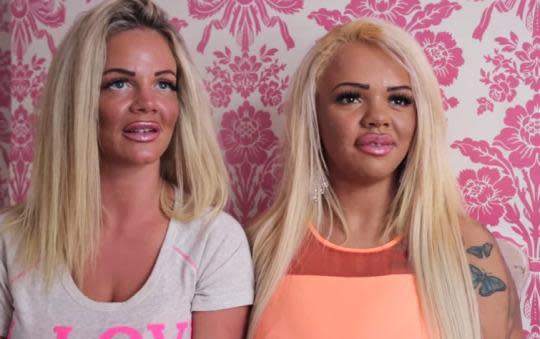Mother and Daughter Spend $86K on Plastic Surgery to Look Like Celeb Idol
A mother-daughter pair claim they’ve spent more than $86,000 on plastic surgery in the last three years in order to look more like a British model and reality star.
Georgina Clarke, 38, and her daughter Kayla Morris, 20, open up in a new video from News Dog Media about what they say is their love of plastic surgery. In the video, Clarke explains that she and her daughter started watching TV personality and model Katie Price years ago, and both thought she had “the whole package.” Price, a household name in the U.K., is famous for, among other things, having had a number of breast enhancement surgeries. “When I was 11 and watching Katie Price, I knew I wanted a boob job and wanted to look like her,” Morris says in the video. “I wanted to look like her.”

Georgina Clarke and her daughter, Kayla Morris, say they have always wanted to look like this picture of British model Katie Price. (Photo: YouTube/New Dog Media)
STORY: Teens Are Getting Back-to-School Plastic Surgery
Some mothers might discourage their young daughters from pursuing plastic surgery at such a young age, but Georgina says she was on board. “I was pleased Kayla wanted surgery and wanted a boob job,” Clarke says on camera. “I was glad because I wanted her to be, like, that kind of person.”
In the last three years, the duo has gotten a number of cosmetic procedures together, including lip injections, Botox, cheek fillers, semi-permanent makeup, teeth whitening, hair extensions, and breast implants, according to News Dog Media. Both women have their enhancements paid for by Morris’s “sugar daddy,” who she says she met when she started stripping at a club at age 17. “I don’t mind Kayla having a sugar daddy or stripping to pay for surgery, because we’re living the dream,” explains Clarke.

Kayla Morris, right, has a sugar daddy who pays for her plastic surgery, and for her mother’s. (Photo: YouTube/New Dog Media)
STORY: Should Parents Let Teens Get Plastic Surgery Like Kylie Jenner?
They’re not done yet, though. Both mother and daughter want more breast implants and to get a butt lift, they say.
And while both Clarke and Morris say they are happy with their looks and their lives, family therapist Dr. Paul Hokemeyer tells Yahoo Parenting that their actions tell a different story. “People who compulsively seek to change their physical appearance to look like someone other than themselves are typically motivated by a deep and unrelenting pain that will never be resolved from a physical enhancement,” Hokemeyer says. “Instead of finding the tools to resolve their internal conflicts, they attempt to manipulate their bodies into objects that can be worshiped from afar, rather than vulnerable human beings capable of dealing with authentic intimacy.”
While he has not treated the mother-daughter pair, Hokemeyer says their story is a sad one. “For [people addicted to plastic surgery], life is safer when lived through external standards — youth, beauty, sex appeal. They become markers of success, when that should be measured by internal standards like self esteem, a sense of place, and altruistic connection to the people around them,” he says. “Unless this pain is resolved it is passed from generation to generation, perpetuating its destructive effect on the family’s physical and emotional well-being.”

Katie Price, the model who inspires Georgina Clark and Kayla Morris, in 2004 (left) and 2015.
Plastic surgeon Dr. Anthony Youn says it’s not uncommon for a patient to reference a celebrity when requesting a new look. “I often have patients who desire, say, a rhinoplasty — or nose job —and bring in a photo of a celebrity whose nose they want theirs to look like,” he says. “Some patients bring in photos of Kim Kardashian’s behind or Scarlett Johansson’s lips. Often, bringing in photos of a celebrity whose certain body part they want to emulate isn’t necessarily a problem. It can be a valuable way for the doctor and patient to make sure that we are on the same page with what the patient wants.”
But there’s a limit, he says, to what is healthy. Using a photo of a celebrity to help communicate a look is different, he says, than “a patient who literally wants to look, or transform herself, into a celebrity. That can be a sign of a major psychiatric disorder, called body dysmorphic disorder (BDD). People who have BDD can have a very distorted view of their own appearance, and often undergo repeated plastic surgeries in a misguided attempt to look a certain way.” People with this disorder have high rates of depression and suicide, Youn says, and often don’t realize they have a problem.
While it can be beneficial to have a supportive family member when going under the knife, Youn says the relationship featured in this video seems to go to extremes. “In this situation of the mother-daughter duo, when the plastic surgery is so obviously overdone and unnecessary, it strikes me as troubling,” he says. “I suspect that this mother and daughter either both suffer from a form of BDD or simply have an unhealthy obsession with plastic surgery, both of which can lead to bad outcomes.”
Rather than continuing to encourage her daughter’s surgeries, Youn says Clarke should be encouraging Morris to be happy with who she is. “I strongly believe that the most appropriate [approach] to plastic surgery is to do the least amount necessary to make a person happy,” he says. “That’s what I encourage of my patients, and what this mother should be encouraging of her daughter.”
Please follow @YahooParenting on Facebook, Twitter, Instagram, and Pinterest. Have an interesting story to share about your family? Email us at YParenting (at) Yahoo.com.

